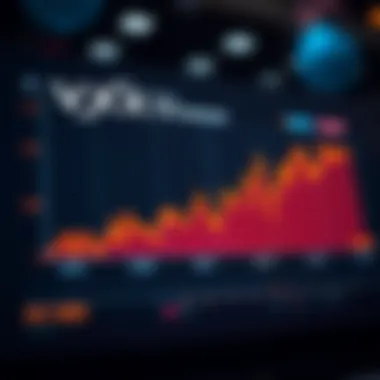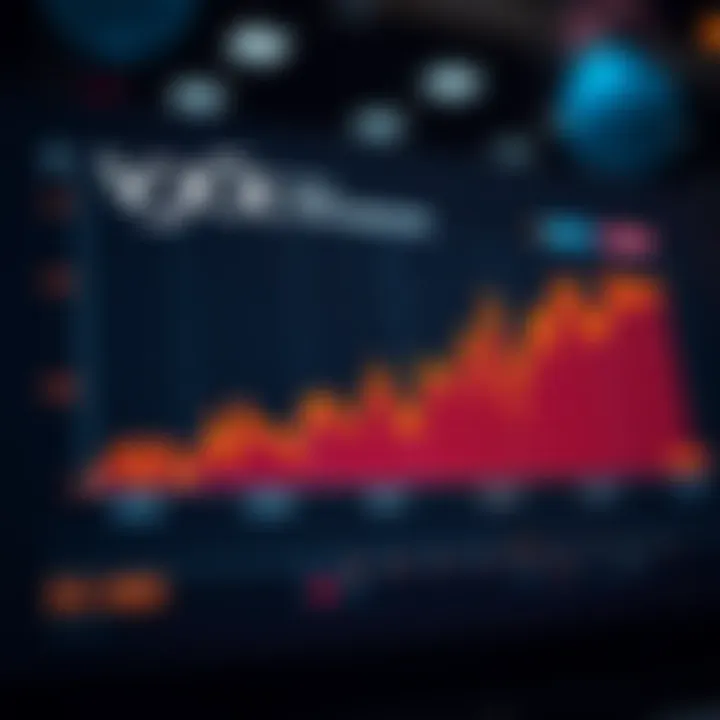Understanding VXX: Mechanisms and Market Influence


Intro
The world of finance is often a maze, where market fluctuations and investor behaviors create a complex web of opportunities and pitfalls. In this environment, volatility exchange-traded notes, or ETNs, like VXX come into play as a useful tool for those looking to navigate these ups and downs. Understanding how these instruments operate is not just for the finance whizzes or Wall Street gurus; it's essential for anyone attempting to make sense of market uncertainty.
In this article, we will thoroughly explore the mechanisms behind VXX, breaking down its function, its impact on your investments, and how it interacts with broader financial concepts. By the end of this deep dive, our aim is to furnish you with insightful knowledge, helping you make informed investment choices when considering volatility. Let's roll up our sleeves and dive into the nuances of VXX.
Prolusion to
Understanding VXX is paramount for anyone steeped in the finance world, whether you’re an investor, analyst, or student of the markets. In a landscape often marked by uncertainty, VXX serves as both a beacon and a tool for navigating volatility. By peeling back the layers of this exchange-traded note (ETN), one can grasp not only its mechanics but also the broader implications it holds for financial strategies and market sentiment.
Defining
VXX, or the iPath Series B S&P 500 VIX Short-Term Futures ETN, is an exchange-traded note designed to give investors exposure to the volatility of the S&P 500 Index. It tracks the performance of the Chicago Board Options Exchange (CBOE) Volatility Index (VIX) futures. Unlike traditional stocks, VXX is not a stock but a debt instrument; its value is derived from VIX futures, which are contracts based on the expected volatility of the S&P 500.
Investors utilize VXX largely as a tool for speculation or hedging. In other words, while some may use it to profit from rising volatility, others might turn to it to protect their portfolios against downturns. Capable of spiking in value when the market gets jittery, it can present sharp, albeit short-lived, investment opportunities. Investors should recognize that VXX is primarily geared for short-term strategies; its effectiveness dwindles over time due to the structure of the futures it tracks, making it essential to keep a watchful eye on market trends.
Purpose of in Financial Markets
VXX plays a critical role in how investors manage risk and seek opportunities amid unpredictable market behavior. Here are some key purposes that make VXX a relevant instrument in today’s finance landscape:
- Volatility Benchmark: VXX is often viewed as a benchmark for gauging market fear, which can influence investment and trading decisions.
- Strategic Tool for Hedges: For investors heavily involved in equities, VXX provides a way to hedge against potential losses during market declines. Essentially, it acts as an insurance policy against volatility spikes.
- Diversification: By including VXX in a broader portfolio, investors can achieve greater diversification, smoothing out potential risks associated with more traditional investments.
- Speculative Opportunities: Investors looking to capitalize on short-term market movements can trade VXX for speculative gains, taking advantage of rapid fluctuations in volatility.
In sum, VXX is not just a trading vehicle; it’s a representation of investor sentiment and market dynamics. As such, it necessitates a nuanced understanding to leverage its full potential in creating robust investment strategies.
The Structure of
The structure of VXX is a crucial element in understanding how this volatility index functions and influences market dynamics. This section will delve into the intricate components that make up VXX, shedding light on why these aspects are essential for anyone interested in volatility trading. By breaking down VXX's foundational elements, readers can gain a more comprehensive understanding of its operation in the financial markets.
Underlying Components
Volatility Index
The Volatility Index, commonly referred to as the VIX, is often dubbed the market's “fear gauge.” This index is pivotal because it reflects the market's expectation of future volatility based on options prices of the S&P 500. Understanding the VIX is vital, as it serves as a benchmark for investors assessing market risk.
The key characteristic of the VIX is its ability to provide a sneak peek into the market's mood. High VIX values typically indicate a spike in market anxiety, while lower values suggest a more complacent atmosphere. Its contribution to VXX cannot be overstated; without the VIX, there would be no barometer to measure implied volatility in the options market, rendering VXX nearly irrelevant.
A unique feature of the VIX is its forward-looking nature; it predicts market volatility for the upcoming 30 days. This characteristic can be beneficial for investors looking to understand potential price swings before they occur. However, there are disadvantages too. The VIX can sometimes overreact to market news, leading to erratic behaviors that may mislead investors.
Futures Contracts
Futures contracts are the bread and butter of volatility products like VXX. At its core, VXX tracks a portfolio of VIX futures contracts, which are agreements to buy or sell the VIX at a future date for a predetermined price. This mechanism of relying on futures contracts is what allows VXX to maintain a connection to expected future volatility.
The impressive aspect of futures contracts is their functionality in speculation and hedging. Investors use these instruments to bet on future changes in volatility—this component of VXX is advantageous for those wanting exposure without direct investment in the underlying index.
However, there exists a double-edged sword. The unique feature of futures contracts is rolling them over. As the contract nearing expiry approaches, VXX has to ‘roll’ into new contracts. This can lead to a drag effect known as negative roll yield, particularly in contango markets, where future prices are above current prices. For VXX investors, understanding this dynamic is critical to managing long-term positions.
ETN vs ETF: Key Differences
The distinction between an Exchange-Traded Note (ETN) like VXX and an Exchange-Traded Fund (ETF) can often be confusing for investors. While both are traded on exchanges and provide liquidity, their structures vary significantly.


- Nature of the Product:
- Tax Considerations:
- Structure and Management:
- An ETN is essentially an unsecured debt security issued by a financial institution. This means it carries the issuer's credit risk. On the other hand, an ETF holds a collection of assets, providing a tangible backing that protects investors.
- ETNs often have different tax implications than ETFs, mainly due to how returns are classified. In certain situations, gains in ETFs may be subject to capital gains tax, while ETNs may offer more tax-efficient tracking of their underlying index.
- ETFs track indices through a direct holding of the underlying assets, while ETNs rely on the creditworthiness of the issuer to pay returns. This aspect introduces another layer of risk for ETN investors.
These differences are pivotal for investors when deciding between the two, especially in terms of risk tolerance and investment strategy.
Understanding the structure of VXX and the nuances between ETNs and ETFs can really shape an investor's approach to market volatility. It equips them with the knowledge to make informed financial decisions in a turbulent environment.
How Operates
Understanding how VXX operates is pivotal for anyone looking to navigate the increasingly complex waters of investment in volatility products. This section lays bare the intricate processes underpinning VXX, highlighting not only its calculation methods but also the various factors that influence its pricing. Anyone who's even slightly familiar with financial markets knows that volatility can spike unexpectedly, making it crucial to grasp the mechanisms at play in the VXX framework.
Calculation of Value
To comprehend the VXX value, it is essential to know that it generally tracks the performance of futures contracts on the CBOE Volatility Index (VIX). Specifically, this ETN seeks to reflect the returns of a daily rolling investment in VIX futures.
The formula itself may sound highfalutin, but let’s break it down. The value of VXX is derived from the weighted average of the prices of VIX futures, usually with a one-month to two-month horizon, rolled over on a daily basis. One unique element to consider is that VXX does not reflect the VIX itself, but rather the anticipated volatility over the following month, leading to potential discrepancies between VXX movement and actual VIX fluctuations.
Additionally, keeping an eye on factors like contango and backwardation in the futures market is important as these directly affect VXX’s value. In periods of contango, where near-term futures are priced lower than longer-term ones, VXX can suffer because it has to buy more expensive contracts as it rolls over, often leading to depreciating returns.
Influences on Prices
Market Conditions
Market conditions, quite often, lay the foundation for VXX pricing dynamics. When market uncertainty looms – say due to geopolitical tensions or economic downturns – the level of implied volatility invariably rises, prompting VXX prices to climb. This characteristic of market conditions acts as a bellwether, indicating heightened investor concerns about future market fluctuations.
One unique feature of market conditions to note is their cyclical nature. During bull markets, volatility tends to be low, leading to a potential depreciation of VXX. Conversely, in bear markets, the very instability can fuel demand for such volatility products as investors seek hedging mechanisms. This oscillation is not merely academic; it can have real implications for anyone considering exposure to volatility through VXX.
Investor Sentiment
Investor sentiment also plays a critical role in shaping VXX prices. Behavioral finance tells us that emotions often dictate trading. When fear grips the market, investors rush to buy volatility as a safe haven, thereby driving VXX prices up. Conversely, in times of exuberance, the appetite for volatility wanes, leading to its depreciation.
An interesting aspect of investor sentiment is how it can lead to overreactions. For example, a minor piece of negative news can cause a disproportionate spike in VXX prices as traders panic, employing strategies to hedge against perceived risks. This emotional fluctuation can create an environment where VXX becomes a barometer for not just market volatility but also psychological market forces, a fact that savvy investors need to keep in mind when devising strategies involving VXX.
In summary, a solid grasp of how VXX operates can significantly enhance one’s investment acumen, especially in a market that can shift like quicksand. Understanding the nuances of its calculation and the external influences that affect its pricing will provide you with the tools needed to make informed—if not strategic—decisions when engaging with this asset class.
Investing in
Investing in VXX can be a significant factor when it comes to hedging against market fluctuations. It is crucial for investors seeking to navigate periods of heightened uncertainty. VXX serves as a reflection of investors’ anticipations regarding future volatility in the market. By including VXX in their portfolio, investors can gain a structured exposure to this volatility, offering both potential opportunities and challenges.
Who Should Consider ?
VXX can cater to a diverse range of investors. For disciplined traders who thrive during turbulent market conditions, VXX represents a tool that can enhance their ability to capitalize on quick shifts in market dynamics. On the other hand, conservative investors looking to mitigate risk may also consider utilizing VXX as a hedging mechanism. Essentially, institutional investors, hedge funds, and even retail investors looking for a strategic move in uncertain times might find VXX particularly appealing.
Risk Factors Associated with Investment


Investing in VXX is not without its risks, and understanding these risks is pivotal for potential investors. Here are the notable risks associated with this ETN, examining volatility risks and liquidity considerations, both of which hold importance in framing a responsible approach to investing in VXX.
Volatility Risks
Volatility risks relate directly to the inherent price fluctuations of VXX. The key characteristic of this risk is its potential to induce substantial losses during periods of market stability. VXX is designed to reflect future volatility, thus when the market stabilizes, VXX typically declines. This means that investors can find themselves on a rollercoaster ride, where sudden drops can lead to unexpected financial challenges. This creates an environment where volatility as a characteristic becomes a double-edged sword; it can work in favor of investors during turbulent periods but can equally lead to swift losses in calmer markets.
- Unique Features: Importantly, VXX does not precisely track the VIX index, leading to potential tracking errors during sharp market movements.
- Advantages and Disadvantages: While it does afford the opportunity for substantial gains, savvy investors must weigh this against the reality of potential steep losses during downturns.
Liquidity Considerations
When discussing investment in VXX, liquidity considerations play a crucial role, especially in conditions of high volatility. The liquidity of VXX can fluctuate, making it challenging to execute trades at favorable prices. This can lead to slippage, where investors pay a higher price or receive a lower price than intended, particularly in fast-moving markets. Additionally, during periods of extreme market stress, liquidity may dry up, exacerbating the risks of holding VXX.
- Key Characteristics: The high trading volume tends to suggest good liquidity, but during significant market events, this may not hold true.
- Unique Features: Moreover, since VXX is an exchange-traded note rather than a mutual fund, it is essential to monitor how changing market conditions can affect its accessibility and pricing.
- Advantages and Disadvantages: High liquidity typically allows for easier entry and exit in positions, but in stressed environments, unexpected challenges may arise, putting investors on alert.
In summary, while investing in VXX can present unique opportunities as well as risks, understanding these dynamics is vital for making any informed decision. To navigate the intricacies of VXX successfully, investors should stay well-informed and ready for shifting market conditions.
Strategies for Trading
Trading VXX effectively requires a clear understanding of both short-term and long-term strategies. Each approach caters to different investment goals, risk tolerances, and market conditions. By dissecting these strategies, investors can leverage the unique characteristics of VXX, thus maximizing their returns and making more informed decisions.
Short-Term vs Long-Term Trading
Short-term trading in VXX concentrates on quick profits and often involves responding to immediate market movements. Traders utilizing this approach may employ techniques such as scalping or day trading to capitalize on rapid fluctuations in VXX prices. The main advantage here is flexibility; traders can respond to changing conditions and potentially profit from increased market volatility. However, short-term strategies can be significantly risky, and without diligent monitoring, investors might find themselves caught in adverse market shifts.
On the other hand, long-term trading takes a more patient approach. Investors look at VXX as a means to manage risk or gain exposure to market volatility over a sustained period. This method emphasizes the historical performance of volatility trends rather than daily fluctuations, appealing to those who are willing to endure the ups and downs of the market. While this strategy can help buffer against broad market declines, identifying the right timeframe and maintaining discipline is crucial.
Using in a Diversified Portfolio
Integrating VXX into a diversified portfolio can be a tactical move for both risk mitigation and potential profit.
Hedging Strategies
Hedging with VXX can be a smart way to protect against potential downturns in equity markets. The unique characteristic of hedging strategies using VXX lies in its inverse relationship with overall market performance, particularly during periods of heightened uncertainty. For instance, during market corrections, VXX often sees increased demand as investors flock to safety.
This makes VXX a popular choice for investors who seek to offset losses in equities with gains from volatility increases. The distinctive feature of hedging through VXX is its ability to provide a safety net, reducing exposure to other volatile assets. However, like any strategy, it carries risks; if the anticipated volatility does not materialize, the investment may not perform as expected, potentially leading to losses on the VXX position itself.
Speculative Approaches
Speculative trading in VXX aims at profiting from expected price movements rather than securing against risk. This method often attracts those who are keen on taking calculated risks in anticipation of market shifts.
The key highlight of speculative approaches involves the adaptability to market sentiment. For example, when traders perceive an uptick in volatility, they can initiate positions to ride the wave of price surges. A unique feature of speculation is its reliance on technical analysis and market psychology, letting investors gauge potential opportunities based on observable trends. Nonetheless, it is essential to underscore the inherent unpredictability; speculative approaches can lead to significant losses just as easily as they can offer outsized gains.
Remember, whether trading short-term or long-term, or implementing hedging or speculative strategies, understanding market dynamics is essential to success in VXX trading.
In summary, strategies for trading VXX, whether they are short-term, long-term, or are used within a diversified portfolio, demand a careful balance of risk and reward. By clearly identifying the appropriate strategy in accordance with individual goals and market conditions, investors can more effectively navigate the often turbulent waters of volatility trading.
Comparison of with Other Volatility Products
The landscape of volatility trading reveals a multitude of products designed to help traders and investors navigate uncertain markets. Understanding how VXX stacks up against these alternatives is vital for anyone looking to leverage market volatility effectively. This section dissects the comparative advantages and drawbacks of VXX, particularly in relation to two prominent alternatives: VIX futures and options, as well as other volatility ETFs.
Futures and Options
VIX futures and options represent one of the most established avenues for profiting from market volatility. Unlike VXX, which is an ETN, VIX futures are derivative contracts based on the expected future value of the Cboe Volatility Index (VIX).


The primary draw of VIX futures lies in their ability to provide a direct hedge against volatility spikes. Investors can utilize these instruments to lock in prices for future volatility, giving them more control over their market exposure. Here are some critical points to consider:
- Direct Exposure: Futures contract directly to the VIX, making them ideal for investors looking to gain precise exposure.
- Leverage Opportunities: Traders can utilize leverage for magnified returns, albeit with increased risk.
- Expiration Dates: Futures contracts have set expiration dates, creating potential challenges regarding timing.
On the other hand, VIX options allow for strategic flexibility. Like traditional options, they provide the right (but not the obligation) to buy or sell futures contracts, allowing investors to create tailored strategies depending on market expectations. This can foster more sophisticated trading approaches but also introduces complexities for newcomers.
"While VXX provides easier accessibility, VIX futures and options can offer nuanced strategies, depending on the investor's risk appetite and market outlook."
Other Volatility ETFs
Various volatility ETFs exist, each catering to different investment strategies and risk profiles. While ETPs like the ProShares VIX Short-Term Futures ETF may mirror VXX in seeking returns from movements in the volatility markets, they often differ in their underlying structures and associated risks.
- Tracking Errors: Many volatility ETFs struggle with clear tracking towards their benchmarks. In contrast, VXX aims to mimic the daily performance of a volatility index through its structured approach.
- Management Fees: Different ETFs come with varying management fees which can erode investor returns over time; VXX has a distinct fee structure compared to those of other volatility-focused ETFs.
- Basket of Holdings: Other ETFs may diversify into a basket of related assets which can lead to less direct exposure to volatility spikes, somewhat diluting intended market responses.
Epilogue
In wrapping up our exploration of VXX, it's crucial to highlight not just what the instrument is, but why it holds significance for a wide array of market participants. VXX is not merely a ticker symbol; it embodies a dynamic tool for gauging volatility and hedging against market uncertainty. Investors who grasp its mechanics can leverage it strategically, but they must also navigate the complexities that come with it.
Recap of Functionality
To reiterate, VXX derives its value from the CBOE Volatility Index (VIX), which measures market expectations of future volatility. It serves primarily as an indicator of investor sentiment and can be a valuable asset in periods of heightened market instability. The way VXX functions entails understanding the underlying futures contracts it holds—these contracts are not static and require careful analysis due to their impact on VXX's performance. Furthermore, it’s essential to remember VXX is an exchange-traded note (ETN), which sets it apart from traditional ETFs. This distinction means that VXX carries the credit risk of the issuer, adding another layer of consideration for investors.
"VXX's role as a volatility gauge underscores the complex dance between market perceptions and actual economic indicators."
Future Outlook for Volatility Investments
Looking ahead, the landscape for volatility products, including VXX, suggests evolving dynamics influenced by broader macroeconomic factors. As markets continue to experience shifts—whether due to geopolitical tensions, economic data releases, or technological advancements—investors may find new opportunities and challenges in trading volatility. The proliferation of financial instruments that mimic or hedge against volatility suggests a growing market, yet caution remains paramount.
The future will likely dictate that investors who stay well-informed and agile in their strategies will navigate volatility landscapes most successfully. Continuing education—through books, courses, or professional insights—becomes imperative as market conditions can change on a dime.
Resources for Further Learning
Understanding the complexities of VXX and its role in the financial markets is essential for anyone looking to navigate the often tumultuous waters of volatility investments. Resources for further learning not only enhance one’s grasp of theoretical frameworks but also provide the practical tools necessary to make informed decisions. They can illuminate the nuanced relationships between VXX and broader market metrics, paving the way for strategic investments.
By diving deeper into available literature and educational platforms, investors, educators, and finance professionals can cultivate a more robust understanding of how to leverage volatility as an asset class. Here are some tailored options to consider:
Books on Volatility and Investments
Books on volatility and investments can serve as a solid foundation for understanding the principles underlying market fluctuations. Here are a few notable recommendations:
- "Options Volatility Trading" by Adam Warner: This book demystifies volatility and offers hands-on strategies for trading options based on volatility forecasts.
- "The Volatility Edge in Options Trading" by Jeff Augen: A practical guide that emphasizes utilizing volatility to improve trading results, ideal for those looking to refine their trading strategies.
- "Market Volatility" by Robert E. Whaley: This book provides a comprehensive overview of volatility in financial markets with thorough explanations of its measurement and implications.
Investing time in these books can provide a strong conceptual understanding and practical insights necessary for entering the volatility trading universe.
Online Courses for Investors
The realm of online education offers a plethora of courses focused on volatility and investment strategies. Here are some recommended platforms:
- Coursera: Offers courses like "Financial Markets" by Yale University, which includes segments on risk and volatility; perfect for understanding the broader picture.
- edX: Features courses such as "Introduction to Corporate Finance" where volatility is discussed in the context of investment risk.
- Udemy: Check out specific courses dedicated to options and volatility trading that cater to both beginner and advanced levels.
Online courses can provide interactive learning experiences and up-to-date insights from industry experts, making them invaluable for both novice and seasoned investors alike.
"Knowledge is the first step towards success in financial markets, particularly in areas as unpredictable as volatility trading."
Incorporating findings from both books and courses can cultivate a well-rounded perspective, crucial for anyone aiming to excel in the field of volatility investments. Whether through self-study or guided courses, the journey into understanding VXX and its mechanisms can bear significant fruit.







